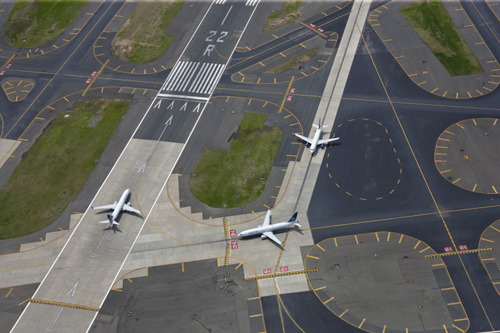
(Ecns.cn) – More than 70 percent of China's existing airports located primarily in the western and central regions of the country are losing money, yet local governments still remain enthusiastic about airport construction, noted the state-run Oriental Outlook magazine.
The building rush will continue for at least three years, with the number of airports expected to reach over 230 by 2015, according to the 12th Five-Year Plan for the Chinese civil aviation industry.
The expansion of airport infrastructure has been justified by the rapidly increasing demand for air travel in recent years; however, many worry that it may become a potential source of over-investment across the economy and create excess capacity in the transport sector.
Westward expansion
In recent years, cities in western and central China such as Changsha, Shijiazhuang, Zhengzhou, Chengdu, Kunming, Handan and Kashgar have all stepped up their pace of airport construction.
According to Li Jiaxiang, head of the Civil Aviation Administration of China (CAAC), the government will gradually shift its focus from the eastern and southern regions to western and central regions in the 12th Five-Year Plan period.
With an investment of 425 billion yuan (US$67.5 billion) between 2011 and 2015, a total of 56 new airports will be built, 16 airports will be relocated and 91 will be renovated and expanded, said Li.
The CAAC has recently approved the location of the Shache Airport to be built in the Xinjiang Uygur Autonomous Region, and is guiding the local government through further research on the construction of three other new airports in Tazhong, Kroraina (Loulan) and Tumxuk.
Southwest China's Yunnan Province is also a key area in the airport building boom. As an ideal travel destination, the local airport capacity must be substantially increased to provide better service.
The Kunming Wujiaba International Airport was completed in 1922, and was the second civil airport in China. After being renovated and expanded three times, the designed capacity has reached 8 million passengers per year, but in 2010 the number of passengers hit 20 million.
Relocation of the airport has become the inevitable choice. According to the CAAC, the Kunming Changshui International Airport in Yunnan will begin operation in the first half of 2012. By 2015, Yunnan Province will have 19 airports.
Losses overshadowed by benefits?
On November 26, 2011, Miss Xie, who took Flight MU2331 from Hefei to Urumqi, received a bouquet of flowers and a free air ticket for being the lucky 4 millionth passenger to fly from Hefei Luogang International Airport that year.
It was an historic moment, especially since Hefei, the capital of Anhui Province, was relocating its airport and expanding capacity to meet increasing travel demands. Based on the experience of the Chinese civil aviation industry, an airport can only start to achieve profitability once it moves over one million passengers every year.
However, not all airports earn money in China. In 2010, 130 out of 175 airports lost a total of 1.68 billion yuan (US$267 million), said Li Jiaxiang at a press conference in February last year.
Despite voices against the airport building spree, Gao Jinhua, professor at the Civil Aviation University of China, pointed out that profitability cannot be judged just by looking at the airport itself, since airports are vital to businesses and help boost local economies. The ratio between input and output in civil aviation is 1:8, according to information from the CAAC.
Airports can generate 130 million US dollars per one million passengers and create 2,500 jobs, according to a study from Airport Council International (ACI). And according to domestic studies, one million passengers can bring economic benefits worth 1.8 billion yuan (US$286 million) and over 5,300 jobs.
In 2008, after the Mohe County Airport was put into use in the far north of Heilongjiang Province, area farmers earned up to 3,000 yuan (US$476.7) a day by offering farm tours. In the past that was their income for an entire year, according to Oriental Outlook.
Li Jiaxiang also noted that the scale of losses China's airports are suffering is very small, while medium- and large-sized airports are usually making fat profits, especially those in Beijing, Shanghai, Shenzhen and Guangzhou.
Chasing profits
On November 22, 2011, it was reported that the construction of Guangdong's Jieyang Chaoshan Airport was halted by the Ministry of Environmental Protection because the project had been started without authorization.
The incident revealed the eagerness to build airports by many local governments, who sometimes turn a blind eye to environmental assessment reports.
In this case, the new Chaoshan Airport was designed as a medium-size domestic airport with a grade 4E flight area, which would make it the largest civil airport in east Guangdong Province. As a result, the sights of the local government remain fixed only on the foreseeable profits, while other factors were ignored.
The issue of input and output in civil aviation is without a doubt the most important factor we take into consideration, but the comprehensive utility of an airport is the ultimate gauge, said Li Jiaxiang.
Civil airports should take more responsibility for public service, such as national defense and rescue and relief work, said the Oriental Outlook.

Copyright ©1999-2011 Chinanews.com. All rights reserved.
Reproduction in whole or in part without permission is prohibited.